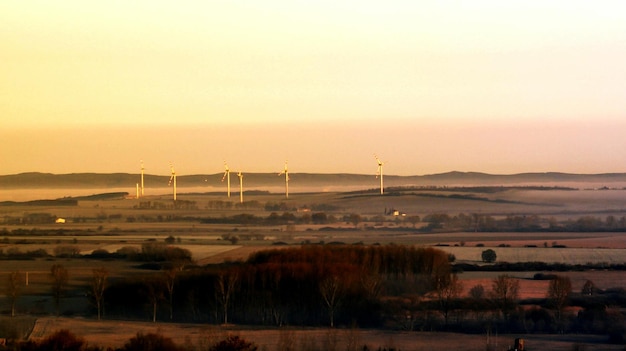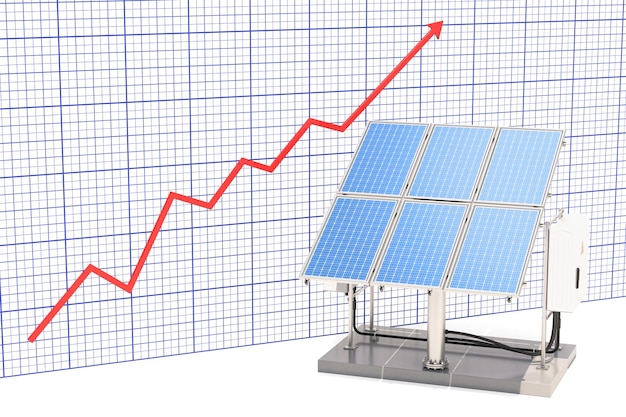Investing in Renewable Energy: Your Guide to Sustainable Profits

Investing in renewable energy offers sustainable profits through various avenues like direct investments in renewable energy companies, mutual funds focused on green energy, and even through government incentives supporting renewable energy projects.
Ready to learn about investing in renewable energy: a step-by-step guide to sustainable profits? Here’s what you need to know.
Understanding Renewable Energy Investments
Investing in renewable energy is becoming increasingly popular as the awareness of climate change grows, and the technology becomes more efficient. Knowing the basics is key before diving in.
Renewable energy includes sources like solar, wind, hydro, and geothermal. These are naturally replenished and produce little to no greenhouse gases. Investing in these sectors supports a sustainable future and can offer financial rewards.
Types of Renewable Energy Investments
There are various avenues for entering renewable energy investments. Each has its own level of risk and return.
- Stocks: Investing in publicly traded companies involved in renewable energy, such as solar panel manufacturers or wind turbine producers.
- Bonds: Buying bonds issued by companies or governments to fund renewable energy projects.
- Mutual Funds and ETFs: Investing in funds that specialize in renewable energy companies, offering diversification.
- Direct Investments: Funding specific renewable energy projects, such as solar farms or wind parks.
Consider the diversification when choosing your investment method. While high returns make certain stock appear attractive, a balanced portfolio with some allocation to bonds or mutual funds is safer.

Assessing the Renewable Energy Market
Before investing, it’s essential to assess the overall market conditions and future trends. Researching the market can reveal potential risks and opportunities.
The renewable energy market is influenced by government policies, technological advancements, and economic factors. Understanding these elements can help investors make informed decisions.
Key Market Indicators
Keep an eye on the following metrics as you assess the renewable energy market:
- Government Policies: Subsidies, tax incentives, and regulations that promote renewable energy.
- Technological Advancements: Improvements in efficiency and cost-effectiveness of renewable energy technologies.
- Market Demand: The overall demand for renewable energy driven by consumers and businesses.
- Economic Factors: Interest rates, inflation, and economic growth that can impact investment returns.
Always diversify to decrease your risk and raise income potential. When you invest in a wide array of industries, it ensures that some segments of your portfolio will withstand any adverse economic changes.
Step-by-Step Guide to Investing
Investing in renewable energy might seem complex, but it can be simplified with a clear strategy.
Here’s a step-by-step guide to help you navigate the world of renewable energy investments.
Step 1: Define Your Investment Goals
Determine your investment objectives, risk tolerance, and time horizon. Are you looking for long-term growth or short-term gains?
Step 2: Conduct Thorough Research
Research different renewable energy companies, technologies, and market trends. Use reliable sources to get accurate information.
Step 3: Choose Your Investment Method
Select the investment method that aligns with your goals and risk tolerance. Consider stocks, bonds, mutual funds, or direct investments.
Step 4: Open an Investment Account
Open an account with a brokerage, mutual fund company, or investment platform. Ensure they offer access to the renewable energy investments you want.
Step 5: Fund Your Account
Deposit funds into your investment account. Consider setting up regular contributions to build your portfolio over time.
Step 6: Monitor Your Investments
Regularly review your portfolio and track performance. Stay informed about market trends and adjust your strategy as needed.
Setting financial objectives is very important. Knowing how much you want to invest and the return you hope to realize on that investment are the first steps to building a successful portfolio.

Analyzing Renewable Energy Companies
Understanding how to analyze renewable energy companies is crucial for making informed investment decisions.
Several factors can affect the performance and profitability of these companies. You should analyze these factors to know for sure.
Financial Metrics
Review key financial metrics like revenue growth, profit margins, and debt levels. Healthy financials indicate stability and growth potential.
Technological Innovation
Assess the company’s commitment to innovation and its ability to stay ahead of technological advancements. Innovative companies are more likely to succeed in the long run.
Market Position
Evaluate the company’s market share, competitive advantages, and geographic reach. A strong market position can lead to sustainable growth.
Risks and Rewards of Renewable Energy Investments
Like any investment, renewable energy comes with its own set of risks and rewards.
Understanding these aspects can help you make informed decisions and manage your portfolio effectively.
Potential Rewards
Here are rewards you might gain from investing in this sector:
- High Growth Potential: Renewable energy is a rapidly growing sector with significant potential for long-term growth.
- Environmental Impact: Investing in renewable energy supports a sustainable future and reduces carbon emissions.
- Government Incentives: Many governments offer tax credits, subsidies, and other incentives to promote renewable energy investments.
Potential Risks
Here are the risks you should consider before investing.
- Market Volatility: Renewable energy stocks can be volatile and sensitive to market fluctuations.
- Regulatory Changes: Changes in government policies and regulations can impact the profitability of renewable energy projects.
- Technological Obsolescence: Rapid technological advancements can make existing renewable energy technologies obsolete.
Knowing risks enables investors to know what problems to expect and make a plan for dealing with these problems. Managing risk well ensures longer and larger revenues.
Sustainable and Ethical Considerations
Integrating sustainability and ethical considerations into your investment strategy can align your financial goals with your values.
Consider the environmental, social, and governance (ESG) factors when evaluating renewable energy companies.
ESG Factors
ESG factors include:
- Environmental Impact: The company’s environmental policies, carbon footprint, and efforts to reduce pollution.
- Social Responsibility: The company’s labor practices, community engagement, and human rights record.
- Corporate Governance: The company’s leadership structure, ethics, and transparency.
Always check into the ethical commitments of a business. Supporting a business that supports your beliefs encourages a better world for everyone.
| Key Point | Brief Description |
|---|---|
| 🌱 Market Growth | Investing in a sector with vast potential due to environmental awareness. |
| 💰 Investment Methods | Various options like stocks, bonds, and mutual funds offer diverse risk levels. |
| 📝 ESG Factors | Ethical investing incorporating Environmental, Social, and Governance criteria. |
| 🎯 Goal Setting | Defining clear investment goals and aligning values with your financial strategy. |
Investing in Renewable Energy: A Step-by-Step Guide to Sustainable Profits
What are the main types of renewable energy investments?
▼
Renewable energy investments include stocks in green companies, bonds funding green initiatives, mutual funds, and direct project funding.
How do government policies impact renewable energy investments?
▼
Subsidies and tax incentives enhance investments, while regulatory changes and legislation may negatively affect them, especially if new restrictions are implemented.
What are the key risks associated with investing in renewable energy?
▼
Market volatility and tech obsolescence are the primary risks. Governmental regulation changes can also greatly impact project revenue predictions.
What is ESG, and why is it important in renewable energy investments?
▼
ESG, which stands for Environmental, Social, and Governance, ensures sustainable and ethical investing. The three pillars improve accountability and encourage smart investing.
How can I assess the financial health of a renewable energy company?
▼
Evaluate revenue growth and profit margins for success. High debt can be troublesome, so do some financial reconnaissance before committing to invest.
Conclusion
Investing in renewable energy offers a path towards sustainable profits while supporting a greener future. By understanding the market, assessing companies, and considering ethical factors, now is the right time to get started.





